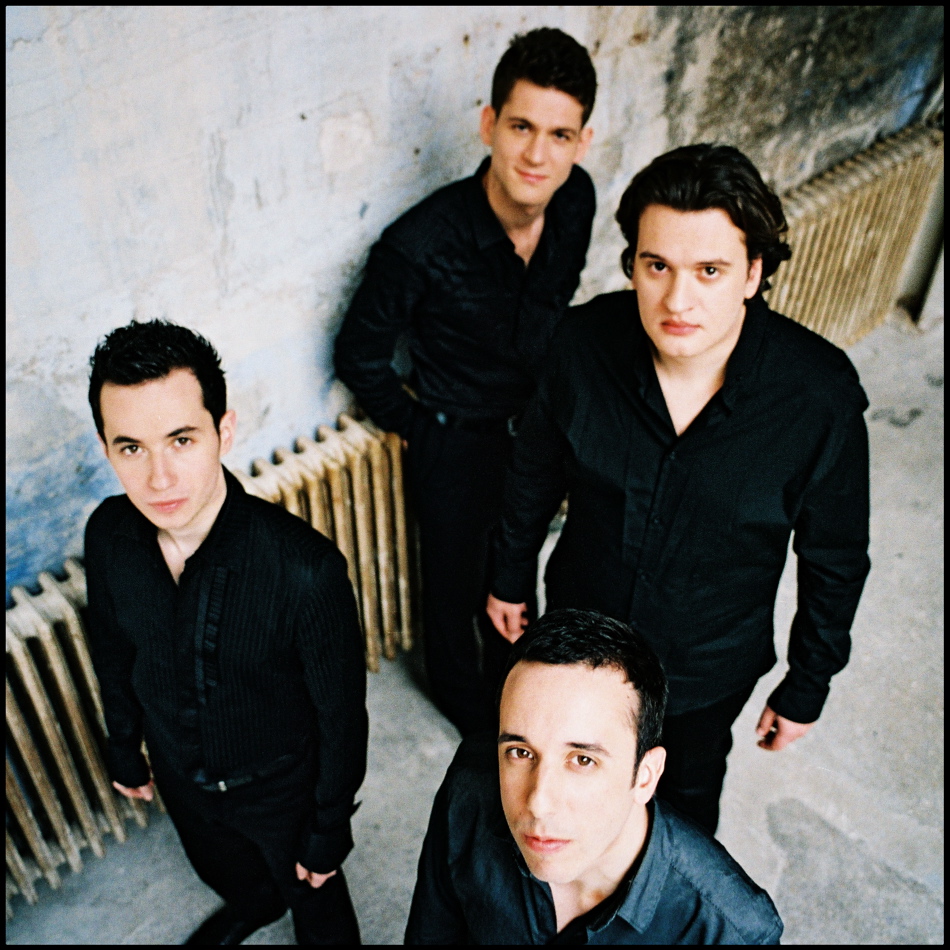Quatuor Ebène traverses the jazz-classical divide from Mozart to Miles

The Quatuor Ebène performed Friday night at Jordan Hall, an event presented by the Celebrity Series.
In the string quartet world, to play both Mozart and Bartók well is considered quite a demonstration of versatility. When Quatuor Ebène plays Mozart and Bartók well, it’s just getting started.
The group displayed its elegant stylings, which would be equally at home in a jazz club as in a concert hall, Friday night at New England Conservatory’s Jordan Hall. A modest-sized audience attended the concert presented by Celebrity Series of Boston, enthusiastically applauding performances of Mozart’s E-flat major Quartet, K. 428, and Bartók’s Third Quartet, then sticking around for a second half titled simply “Fiction” (the title, it turns out, of the quartet’s 2010 album of jazz standards and world music).
In remarks from the stage, cellist Raphaël Merlin complimented the post-intermission audience on being “open-minded,” as if he had expected something else in Boston. Fortunately, listeners had left their flat-brimmed hats and buckled shoes at home—although they did need a bit of conducting by violist Mathieu Herzog to remind them that, in jazz, it’s customary to clap for a solo.
The ensemble’s name means “Ebony Quartet,” and, intentional or not, the echo of Stravinsky’s Ebony Concerto suits this group’s smooth, boundary-defying aesthetic to a T.
In fact, if there was anything missing in these rich, nuanced performances of everything from minuets to movie music, it was a willingness by the players to get their hair mussed a little. Poise, polish, and balance were the watchwords even in such transgressive music as Bartók’s Third, one of his most intense and concentrated works, and Astor Piazzola’s fiery Libertango.
In the Ebène’s performance, one was reminded what a conservative work Mozart’s K. 428 was, not just dedicated to Haydn but aping the older master in many details. The mischievous “Amadeus” rarely peeped out of this score, except in the minuet, with its droll hee-haw theme and its mysterious, volatile, minor-key trio.
But there was also something admirable about the group’s steady, unruffled tempos, which put the burden of expression where it belonged, on imaginative phrasing and interplay between instruments. In these areas, the quartet delivered handsomely all evening.
The slender, silky tone of the Ebène’s Mozart gave way to something more robust and deep-hued as the Bartók got under way. But the more the style changed, the more it remained the same; the Hungarian’s precedent-shattering dissonances never sounded more sensuous and approachable, like blue notes in a jazz ballad. In the work’s up-tempo second section, the ensemble finally added a touch of spicy seasoning, the rough sound of horsehair on metal. A little incisiveness went a long way in the Ebène’s elegant sound world, and in the end all that restraint proved an effective set-up for the rhythmically exciting (though never out of control) coda and stark cry at the end.
In the jazz set, including selections from the Fiction album and other items, there was no sudden stylistic leap; the players sounded like themselves, poised, intelligent, smooth, sensuous, playing music with striking themes, imaginative variations, and shifting harmonic colors. One was reminded of the mutual admiration that has gone on between Ravel and jazz composers.
In these arrangements, all by the Ebène itself, the string quartet medium sounded like no foreigner to jazz, especially its more lyrical idioms. Cellist Merlin could of course be counted on to lay down a pizzicato bass groove, and the lack of percussion—remedied on their album by a guest drummer—was solved here almost entirely by bowing effects, with only the occasional foot stomp or pat on an instrument’s body. The quartet’s collegial interplay mirrored that of ensembles going back to Miles Davis and beyond.
The set began charmingly with a few wisps of improvisation that coalesced into a lush, adagio version of Errol Garner’s Misty, followed by Nature Boy, made famous by Nat King Cole. Lest listeners suffer a surfeit of smooth, they then swung into a rocking Miserlou Twist. Miles’s classic All Blues swung gently, with Merlin and first violinist Pierre Colombet taking especially brilliant choruses (clap, please).
The obligatory Lennon-McCartney selection was not Eleanor Rigby (which is already for string quartet) or one of their tuneful pop songs but a riskier choice, the funky Come Together from Abbey Road. If the players’ arrangement didn’t quite capture the mysterious atmosphere of the original, they did evoke its dry humor in violist Herzog’s rendition of the repetitious tune, pizzicato espressivo.
In the understatement of the evening, Merlin described the soundtrack of Nagisa Oshima’s 1986 film Max, mon amour as “something you have probably never heard before.” With no original to compare it to, one could relax and enjoy the tender, Ravel-like variations without ever realizing the movie was about a love affair between a French housewife and a chimpanzee.
As mentioned, Friday’s rendering of Piazzola’s Libertango tore no passion to tatters, but the players’ bows put out enough slashing martellato and acidic sul ponticello to give it an authentic flavor, and it closed the concert on a high note of energy.
Ever wonder what French barbershop singing sounds like? For an encore, the string players loosened up their vocal cords to sing the first chorus of Disney’s Someday My Prince Will Come en français (“Un jour mon Prince viendra…”), then swung into instrumental variations ranging from oom-pah to molto rubato con gran sentimento.
The next classical-music presentation of Celebrity Series of Boston is soprano Natalie Dessay with pianist Philippe Cassard, 8 p.m. March 8 at New England Conservatory’s Jordan Hall. celebrityseries.org; 617-482-6661
Posted in Performances